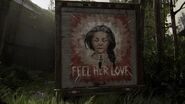| “ | May she guide us.
―The Seraphites chant in honor of their Prophet.[1]
|
” |
The Seraphite Prophet was a character mentioned in The Last of Us Part II.[2][3]
Biography[]
Creating the Seraphites[]
Between September, 2013 and March, 2014 within the Lower Queen Anne suburb in the Seattle QZ, the woman who would come to be known as the Prophet had a supposed vision in response to the Cordyceps brain infection outbreak. This vision inspired her to live an egalitarian life and strive for humanity to detach themselves from physical pleasure and technology. The suburb initially dismissed her but her fierce fighting against the infected gradually swayed them to look up to her.
In time, her charismatic sermons captured the minds of the community's residents, convincing them that the infection was caused by humanity's own sin and served as a second chance for humanity to redeem itself. Inspired, the residents chose to face the infected alone, closing off the community from the wider world. In the meantime, the Prophet had the community grow their own food to secure their independence.[4] They fought the infected without guns, because the Prophet deemed them a part of the 'old world' and 'nested with sin'.[5]
Eventually, the community universally referred to her as "the Prophet".[3] She made a prayer for them all to follow and formally made them into Seraphites.[6]
Encounters with FEDRA[]
By March, 2014, FEDRA and the military located the Prophet's community and were amazed at how the Prophet had secured the residents' survival, with their community being the only one outside the military's protection within the Seattle area that had survived the initial years of the infection's outbreak. The military officers determined the residents were starving and were short on supplies and offered to integrate them into the FEDRA-controlled quarantine zones. However, the group refused, instead wanting to remain under the Prophet's leadership. The Prophet's and her community's efforts were subsequently featured in the Seattle newspaper.[4]
Seattle's military commander Lieutenant Carmelo Torres did not particularly mind the Prophet's refusal to join the zone, citing her "fanatic" group was much less troublesome than the growing terrorist attacks from the city's Washington Liberation Front (WLF) militia.[7]
Rivalry with the WLF[]
After the WLF defeated the military, the Prophet led her community into the formerly FEDRA-controlled suburbs and began preaching her ideas there. Some residents disliked her intrusion.[8][9] In fact, some residents, in fear, joined the WLF to fight against the Seraphites.[10]
However, the Prophet's efforts did lead to members within the suburbs converting to her cause. The WLF grew hostile towards the Prophet and her Seraphites, with their leader Isaac Dixon persecuting members they found, including teenagers like Jimmy, going as far as to execute him.[11][12]
To escape the WLF's tyranny, the Prophet kept her people centralized within Queen Anne. As flooding split the area from the main city, the suburb became an island now a short boat ride from the marina. As such, the Prophet ensured her people lived independently from the rest of the city. They predominantly lived in the southern area of the island, that which faced the marina in Seattle. As such, their city, Haven, was found here.[13][1] The Prophet formed a group of Elders, who acted as leaders within the island's villages to further preach her words and promote the lifestyle she sought her people to live.[14][1]
Sparking a war[]
Despite trying to live in peace, conflict with the WLF became inevitable. To better combat the WLF, The Prophet formed an army among the Seraphites, which contained around five hundred soldiers, according to Yara.[1] The Prophet, according to Abby Anderson, took a group of her soldiers to a supply route the WLF used and destroyed several trucks and killed a patrol of WLF soldiers. This action sparked a guerilla war between the Seraphites and the WLF. However, Lev offered an alternate account, insisting the WLF's actions had left the Prophet with little choice but to fight against the WLF for the Seraphites' own protection.[3]
Capture and death[]
At some point, the WLF successfully captured the Prophet. They held her at one of their outposts near their base. While held there, the Prophet befriended the WLF soldiers who guarded her in her imprisonment. Her words soon persuaded those guards that the war was meaningless and the WLF's lifestyle was not as idyllic as it could be in the post-pandemic world.
One notable account came from Sally, writing to Cam, who remarked that she did not think the Prophet was mentally unstable as WLF propaganda claimed and believed her ideas about living an egalitarian life and one where war with the WLF was non-existent were understandable, even supportable. She also found her rather calm, especially in the face of Lewis' harassment and abusive shouting.
The Prophet's actions led to the WLF's leader, Isaac Dixon, deeming her too dangerous to keep alive. As such, he arranged for her execution.[2]
Legacy[]
After the Prophet's death, the Elders assumed control over the Seraphites and carried on the war in her absence.[3] Her death only increased the Seraphites' fighting spirit, leading to the group launching a lethal assault on the outpost where the Prophet was killed. The Seraphites successfully captured the outpost and forced the WLF to concede the area to their control.[2]
The Prophet became a messianic figure for the Seraphites. They made shrines for her, and carved murals of her into buildings and walls throughout the city.[15][16][1] They would also pray for and to her, especially at Martyr's Gate, which became the area where the Seraphites most frequently prayed.[17] They would pray to her for salvation,[18] personal improvement,[19] success in the war,[20] better lives for their children,[21] for love,[22] and peace with the WLF.[23] They also made it a tradition to carve wood into hand-held statues of the Prophets to hold while praying too.[24]
The Seraphites still waged war against the WLF in the Prophet's name in 2038. They worshiped her as a martyr to their cause, including those who went against the elders' teachings of underage marriage and dismissal of LGBTQ+ individuals and allies, like Lev and Yara.[1][17]
Design and appearance[]
The Prophet was a female with braided black hair.[15] Judging from numerous murals of her scattered around Seattle, she was Caucasian and often wore a white shirt.[16] She also wore blue jeans and walked around bare foot.[25] Her appearance formed the basis for how the females within the Seraphite community looked.[17]
Gallery[]
Official stills[]
References[]
- ↑ 1.0 1.1 1.2 1.3 1.4 1.5 "Seattle Day 3"
- ↑ 2.0 2.1 2.2 WLF soldier meets Prophet letter
- ↑ 3.0 3.1 3.2 3.3 "Seattle Day 2"
- ↑ 4.0 4.1 Locker room note
- ↑ WLF gun cache note
- ↑ Plea to Seraphite Prophet
- ↑ Lt. Torres' final memorandum
- ↑ Last letter to husband
- ↑ Dying husband's plea
- ↑ Pharmacy note
- ↑ Raul's account
- ↑ Fran's refusal
- ↑ WLF scout journal
- ↑ Venison distribution note
- ↑ 15.0 15.1 "Seattle Day 1"
- ↑ 16.0 16.1 "Seattle Day 2"
- ↑ 17.0 17.1 17.2 "Seattle Day 1"
- ↑ Prayer for victory
- ↑ Seraphite prayer to Prophet - Respect
- ↑ Seraphite prayer to Prophet - Steed
- ↑ Seraphite prayer to Prophet - Prosperity
- ↑ Seraphite prayer to Prophet - Pairing
- ↑ Seraphite prayer to Prophet - Peace
- ↑ Whittled statue
- ↑ The Art of The Last of Us Part II, Naughty Dog and Dark Horse Books, 2020, p.199




